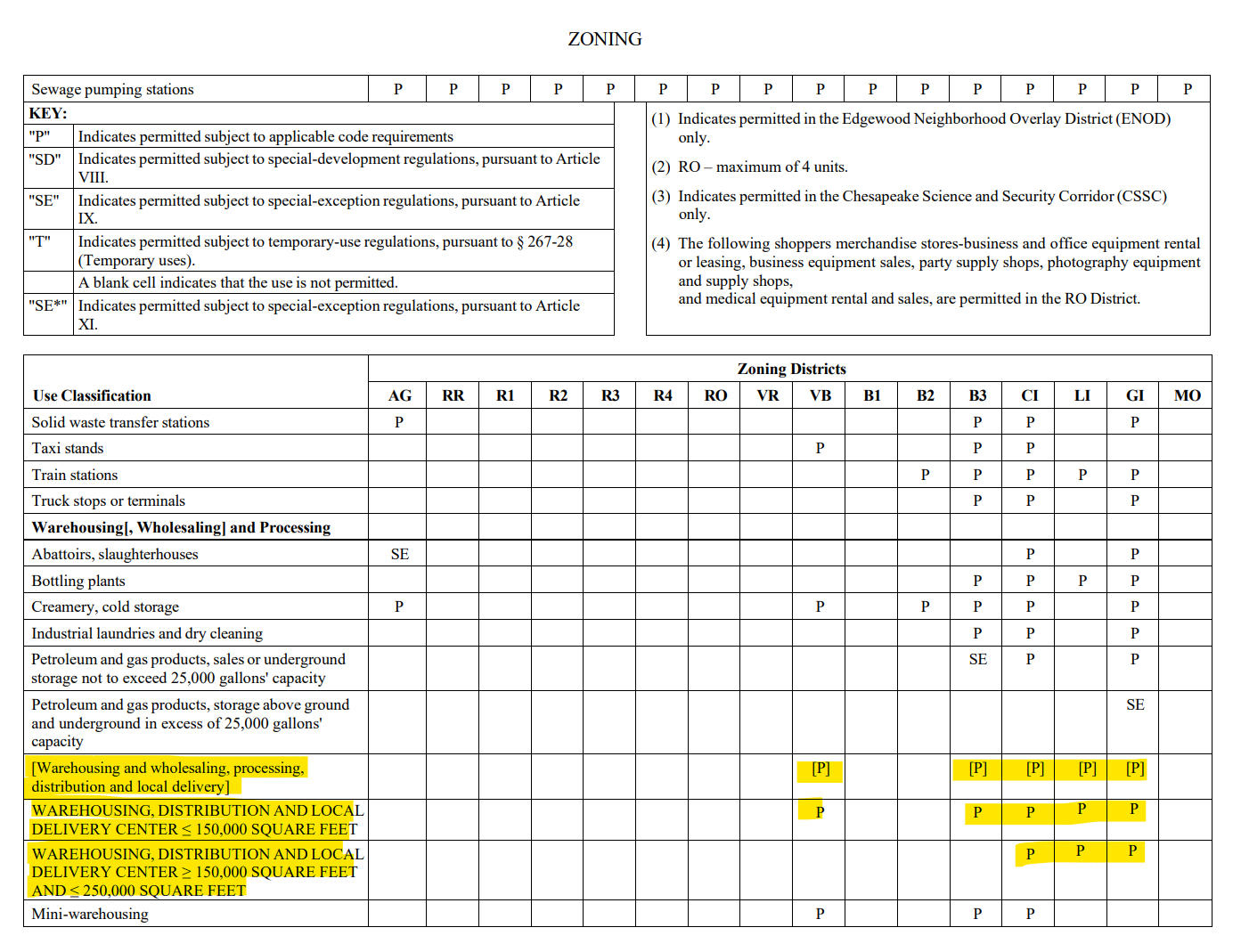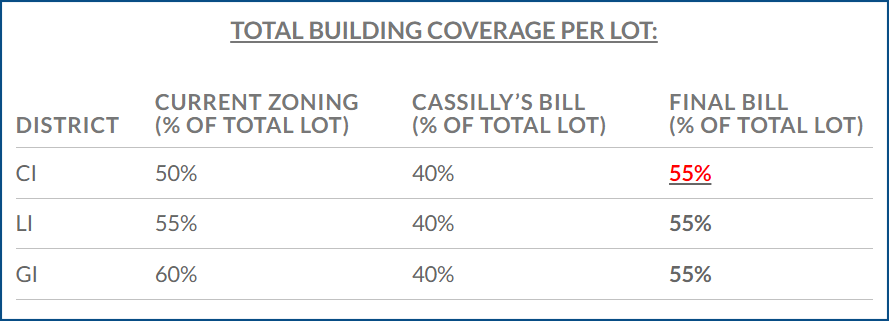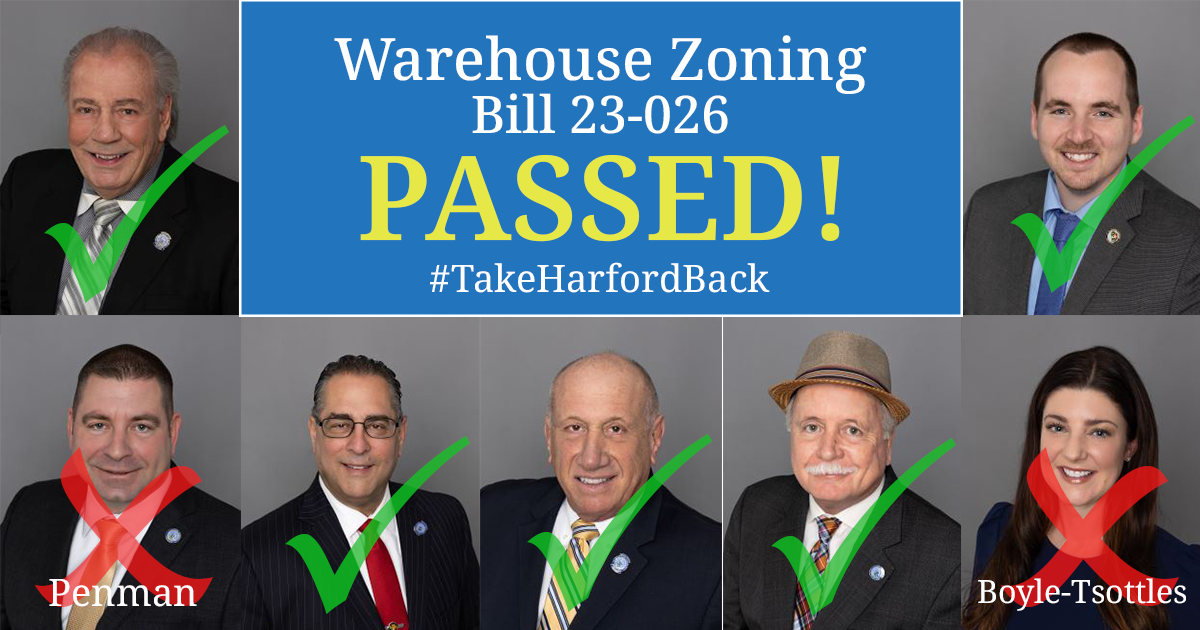On October 10, 2023 the Harford County Council passed the Warehouse Zoning Bill 23-026 as amended with a 5-2 vote. The bill limits warehouse buildings to 250,000 square feet per building with additional requirements to lessen impact on communities. However, non-resident business interests poisoned the guts of the bill by lobbying the Council for destructive amendments.
Warehouse zoning bill summary
The Warehouse Zoning Bill updated use classification “warehousing and wholesaling, processing, distribution and local delivery” to be restricted based on square footage and placed them into 2 new classifications:
- Warehousing, distribution and local delivery less than or equal to 150,000 square feet: Permitted in VB, B3, CI, LI and GI
- Warehousing, distribution and local delivery greater than 150,000 square feet and less than or equal to 250,000 square feet: Permitted only in CI, LI and GI.

267 attachment 19:21
What was gained? Notable improvements included in the bill
- Must have a 100 foot buffer yard on all road sides and sides with residential. Buffer must have an extensive landscape.
- For warehouses 150k-250k the access points into the property must have a minimum setback of 250 feet from any dwelling.
- A 14′ minimum berm along any street and agricultural or residential use zone that borders the warehouse. Additional 14’ tree height line in 3 years.
- No parking or staging areas permitted within water source protection area.
- No grading permit shall be issued until all land right of ways has been acquired, a contract for construction of road called for in the transportation element of the County’s Master Plan has been awarded, and construction has been substantially completed and open to traffic.
- No certificate of occupancy until roads are complete.
- Reduced the ability to increase building height based on increase in setbacks. This limits the height override loophole so that the side and rear yard setback need to increase 2 feet for each 1 foot of height increase. The current zoning loophole allowed 1 foot height for each 1 foot of increased side/rear yard setback.
- Greater than 249 trip rates per day will require a Traffic Input Study conducted by HARFORD COUNTY, but paid for by developer.
- During Development Advisory Committee meeting the developer must provide more details on operations and proposed use.
What was lost? Council amendments poisoned Cassilly’s bill
On the same night the bill was passed, 112 amendments were introduced and voted on without public viewing or comment. In fact, the County Council members had only hours to go through the final amendments to understand the impact before their vote. The bill introduced by the Cassilly administration provided many more restrictions that would have further reduced harmful effects of intense development on the citizens of Harford County. 3P has identified the wreaking amendments which weakened the integrity of the bill first introduced by the Council from the Cassilly administration.
1. Removed the reduction of total building coverage in LI and GI. And increased total building coverage for CI.
The introduced bill reduced the total maximum building coverage per lot from 55% to 40% in LI. Amendment 10 returned it to the existing code of 55% for LI BUT increased it from 50% to 55% in CI. This change significantly changed the intent of the bill to lower intensity of development by allowing greater density of 250K warehouses on CI, LI and GI property.

2. Removed reduction of impervious surface coverage.
The introduced bill reduced the impervious coverage per lot in LI from 85% to 60%. Amendment 11 returned it to the existing code of 85%. This change significantly changed the intent of the bill to lower intensity of development by allowing greater density of 250K warehouses on CI, LI and GI property.
3. Added grandfathering clauses to allow some existing and future warehouses to be exempt.
The grandfather clauses which ensure existing warehouses do not become noncompliant also includes language to exempt future developments or redevelopments located within existing industrial parks. An industrial park is vaguely defined as 4 contiguous commercial lots. This is a large loophole which contradicts the bill itself for commercial lots that have not been developed. The result of this amendment leaves one question if undeveloped commercial lots will all be exempt in the Perryman and Aberdeen’s Technology Drive industrial areas.

4. Removed the restriction of 50% maximum floor area per building.
The introduced bill restricted the maximum gross floor area used for warehousing and distribution at 50%. An amendment removed this restriction.
5. Removed minimum lot size for warehouses 150-250K square feet.
The introduced bill set a minimum lot size of 15 acres for warehouses that are between 150,000 to 250,000 square feet. This restriction was removed.
6. Removed the deletion of freight terminals in B3 and CI.
An amendment removed the deletion of Freight Terminals from B3 and CI use districts in the use charts 19:20.
7. Failed to pass amendment to limit intensity of warehouse projects.
An amendment failed to pass which would have limited the intensity of use by capping the daily trip rates to 1.46 per 1K sq ft of building.


So 50 50 ??
The jury is still out Kevin. We have major concerns about the grandfathering clause which contradicts the rest of the warehouse bill when more than 4 commercial lots are contiguous.
Good summary, thank you.
Glad for gains but sickened by reversals by special interests sneaking them in around public reading and resistance.
I was very disappointed to hear about the circumventing of public input on the amendments. The public never really got to see a draft copy of the complete amended bill before it was voted on. That is not an ideal way to do business in the County.
Thank you Delegate Steve Johnson. The public gets to read and study the introduced bill and have 2.5 hours of public comment, but then after 112 amendments are introduced the Council immediately votes on a bill that guts much of the original bill. Why? The process needs to change.
What are the rules that govern the circumventing of public ability to review the proposal? How is that possible in a fair government of the people and by the people? It smacks of cheating to me.
I feel like this is a lose- lose situation. I had faith that our council representatives would truly help us. My faith is in the toilet now.